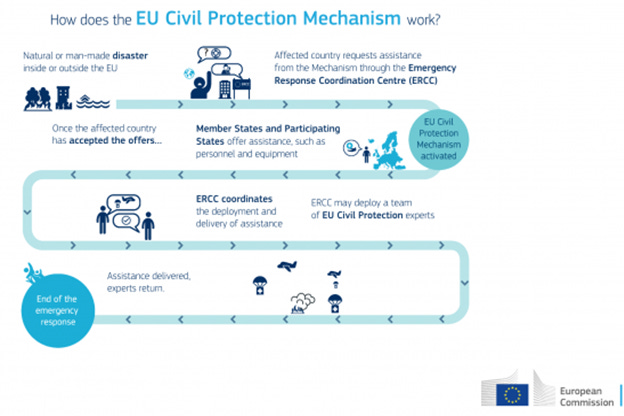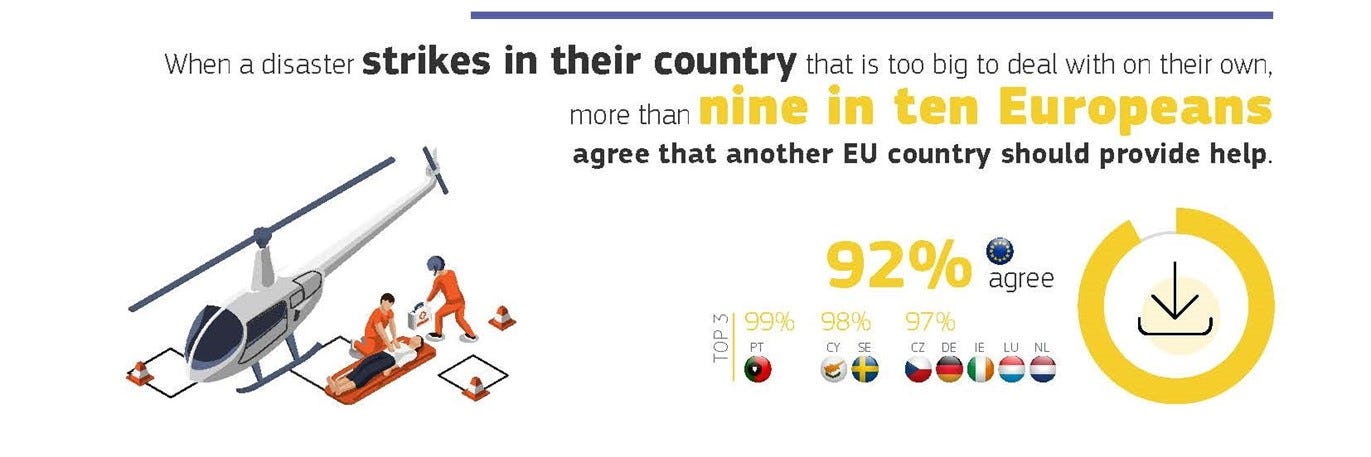For a Nuclear Weapon Attack – the blast zone will be catastrophic, but you may be unaware of a significant hazard which can extend quite farther – an electro-magnetic pulse wave.
In July 2022, New York City’s (NYC’s) Office of Emergency Management (OEM) issued a Public Service Announcement (PSA), to help residents prepare for a nuclear attack. The PSA was most likely predicated on the Russian invasion of Ukraine, compounding the constant threat that NYC is under from all types of hazards. In Emergency Management, which is the broader and hopefully wiser grandchild of Civil Defense, it is prudent to remind the public that these things can happen — and happen here, there, or anywhere. While the focus of that PSA was the radiological impacts of a nuclear weapon, what was missing was the probability that there would be an Electro-Magnetic Pulse (EMP) wave associated with such an attack. Such an EMP would most likely cripple all the local communications networks, including cellular telephone service and (maybe thankfully?) social media access. Not to mention disabling the electrical grid well beyond anything NYC has ever seen in its history.
Many of the planning checklists in Emergency Management for any type of hazard response include telling the public to “stay tuned in and follow the official instructions,” — but this planning assumes two important elements: that those officials can transmit those instructions and that the public can receive them. What if part of the hazard blocks the delivery and reception of these communications, as an EMP might?
In the U.S. Federal Emergency Management Agency’s December 2021 National Preparedness Report, there is a mention of the “less well-understood risks” and the “capabilities needed to manage those risks” with reference to the U.S. Cybersecurity and Infrastructure Security Agency (CISA) and its research work into both EMPs and naturally occurring geomagnetic disturbances, such as those generated by solar flares. CISA’s focus appears to be on critical infrastructure and the possibility of a cascading incident expanding “beyond the initial geographic regions adversely impacting millions of households and businesses.”
EMPs are associated with intentional attacks using high-altitude nuclear detonations, specialized conventional munitions, or non-nuclear directed energy devices. Effects vary in scale from highly local to regional to continental, depending upon the specific characteristics of the weapon and the method of attack. High-altitude electromagnetic pulse attacks (or HEMP, really no kidding, that’s the acronym) using nuclear weapons are of most concern because they may permanently damage or disable large sections of the national electric grid and other critical infrastructure control systems.
And the negative impacts from an EMP do not have to be caused by a no-notice attack from an enemy. A government’s “best intentions” could be to fix another problem. Mark Straus reminded us in National Geographic from 2016 that the idea of the “good guys” deploying a nuclear bomb at high altitudes to stop or quell a different disaster — say a hurricane or a tornado — was in the realm of possibilities:
In a speech delivered at the National Press Club on October 11, 1961, Francis W. Riechelderfer, the head of the U.S. Weather Bureau, said he could “imagine the possibility someday of exploding a nuclear bomb on a hurricane far at sea.” (Although, comfortingly, Riechelderfer added that the Weather Bureau would not begin acquiring its own nuclear arsenal “until we know what we’re doing.”)
And more recently (2019), the internet was filled with stories of how U.S. President Donald Trump was allegedly inquiring about throwing caution to the wind (not to mention throwing away a bevy of nuclear-weapons treaties the United States was a signed party to) and disrupting the paths of tropical storms by dropping nuclear bombs inside of them.
While the radiological, explosive, and other “direct” impacts of any single detonated nuclear device are certainly foreboding and devastating, they will be — in the short-term — geographically limited in scope. The impacts of the accompanying EMP will be more widespread and probably cascade to systems and networks well outside of the blast radius. An EMP’s impact on electronic circuitry — found today in everything from cell phones to cars to airplanes and nuclear power plants — needs to be researched and communicated to the public. U.S President Trump signed Executive Order 13865, which codified the research into protection and prevention aspects of the nation’s critical infrastructure but did not specifically address the probability of permanent damage to unshielded electronic circuits of its citizenry. Everyone’s circuits, not just those of critical infrastructure or governmental operations. In a 2005 article entitled “Empty Threat?” for The Bulletin, Nick Schwellenbach concisely laid out the potential impacts on electronic circuitry from actual nuclear testing conducted in the post-World War II days, including the Starfish Prime experiments. And this was all done before we had the internet and a massive worldwide reliance on cellular networks. Others (Bunn and Roth) have minimalized the EMP impacts, as compared to all the other really bad stuff that happens with a single terrorist nuclear bomb:
Depending on where and when it was detonated, the blast, fire, initial radiation, and long-term radioactive fallout from such a bomb could leave the heart of a major city a smoldering radioactive ruin, killing tens or hundreds of thousands of people and wounding hundreds of thousands more. Vast areas would have to be evacuated and might be uninhabitable for years. Economic, political, and social aftershocks would ripple throughout the world.
Certainly, a ground-level or low-altitude nuclear detonation would have the catastrophic impacts described above. However, EMPs travel in all directions from the blast. Their potential to disrupt and destroy electronic circuitry can also travel above and beyond the blast. Consider airplanes falling out of the skies. Cell towers miles away were permanently destroyed. A high-altitude explosion over the country’s center could impact the entire continental United States’ critical infrastructure with the accompanying EMP. And the EMP will not stop at national borders either.
You will probably know you are in the middle of a ground-level or low-altitude nuclear detonation zone. A few generations have passed since the cold-war days of “duck and cover,” so muscle memory is incomplete in society today. Even the film The Day After is nearly forty years old. The EMP impacts from any high-altitude explosion will be silent and initially disconcerting. Not only will the power go out, but everything electronic that is unshielded will stop working. And those devices may not reboot or operate on batteries. Unlike the 10 minutes or so that one might have to find shelter from the radiological impacts of a nuclear explosion, the effects of the EMP will be almost instantaneous. You will not have time to move electronic devices into shielded storage nor vehicles into underground protected garages. It will be too late to act. From a homeland security perspective, failure to plan for this possibility. is planning to fail.
Individuals and families everywhere should become prepared for this remote possibility of a threat: not just the government and the military. The adverse impacts of the EMP itself (for those outside of the nuclear blast zone and radioactive plume area, of course) are survivable. This does not have to become an extinction-level event, although that is what emergency managers think about and plan: as if it were one level (or more) above what is occurring. Some basic “prepper” supplies will, of course, be required. Still, it is mostly a paradigm shift in one’s planning mindset: away from deterrence and inertia, towards independence from our total reliance on electronic devices, and towards manual equipment and actions to support life safety. It also requires default plans of action by every family member as to what they will do, where they will go, etc., if such an incident were to occur. Remember, this EMP will have no notice, no warning, and everyone will need a different plan when they are at work or home, etc. And when you make your plans, be ready to share them, communicate them, and store them on paper (and update them/reprint them at least yearly or as life events change). Any plans will be no good to you stored on the cloud. If you are a first responder or in a field considered “essential work,” — do you take action to keep your family safe first? Does your manager/supervisor have a different expectation for what you will do today, tomorrow, or even next year?
Yes, the total loss of most of the modern technology of the 21st century will overwhelm most people, but bicycles will still work. So will horses. And so will guns. The U.S. Department of Homeland Security issued guidance on best practices for Electromagnetic Pulse Shielding, and has promised to “target harden” the Integrated Public Alert and Warning System (IPAWS). The best that will do is tell the nation after the fact that an EMP has occurred. And if you do not have a working AM/FM radio, you will not receive those messages. Joshua Good in his 2012 Masters Theses for James Madison University noted that Blackstarting the North American power grid could take months if not years.
When it comes time to act, you can take that paper copy of your plan out of the zip-locked sealed bag and start to go on with your life. And by the way, this type of extinction-level-event planning covers a multitude of smaller, lesser impactful incidents such as hurricanes, winter storms, multi-state wildfires, and earthquakes. And hard to decipher, yet much more frequent Space Weather incidents will be covered, too. Having a default set of actions to take — and communicating them in advance to all concerned — will help everyone with no-notice, no-communications large-scale incidents, such as an EMP. While the uptick in reminders about a possible nuclear attack on major cities in the United States is not “playing Chicken-Little,” waiting for the government to give us all the instructions as to what to do after such a threat should not be our next set of checklist steps for our own safety and security.
Visit the CEMIR website
Get your own Space Weather widget (iframe code):
<div align="center">
<iframe src="http://www.pa2p.nl/swpc/" width="100%" height="342px"
frameborder="0" scrolling="yes" allowtransparency="true"></iframe>
</div>








